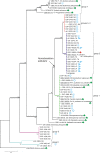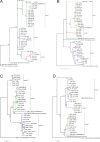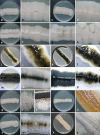Redefinition of Aureobasidium pullulans and its varieties
- PMID: 19287524
- PMCID: PMC2610310
- DOI: 10.3114/sim.2008.61.02
Redefinition of Aureobasidium pullulans and its varieties
Abstract
Using media with low water activity, a large numbers of aureobasidium-like black yeasts were isolated from glacial and subglacial ice of three polythermal glaciers from the coastal Arctic environment of Kongsfjorden (Svalbard, Spitsbergen), as well as from adjacent sea water, sea ice and glacial meltwaters. To characterise the genetic variability of Aureobasidium pullulans strains originating from the Arctic and strains originating pan-globally, a multilocus molecular analysis was performed, through rDNA (internal transcribed spacers, partial 28 S rDNA), and partial introns and exons of genes encoding beta-tubulin (TUB), translation elongation factor (EF1alpha) and elongase (ELO). Two globally ubiquitous varieties were distinguished: var. pullulans, occurring particularly in slightly osmotic substrates and in the phyllosphere; and var. melanogenum, mainly isolated from watery habitats. Both varieties were commonly isolated from the sampled Arctic habitats. However, some aureobasidium-like strains from subglacial ice from three different glaciers in Kongsfjorden (Svalbard, Spitsbergen), appeared to represent a new variety of A. pullulans. A strain from dolomitic marble in Namibia was found to belong to yet another variety. No molecular support has as yet been found for the previously described var. aubasidani. A partial elongase-encoding gene was successfully used as a phylogenetic marker at the (infra-)specific level.
Keywords: Arctic; Aureobasidium; ITS; LSU; black yeasts; elongase; glacier; phylogeny; polar environment; rDNA; sea ice; seawater; taxonomy; translation elongation factor; β-tubulin.
Figures


 - plant associated;
- plant associated; - originating from
Arctic ice;
- originating from
Arctic ice; - originating from
hyperosmotic environment;
- originating from
hyperosmotic environment; - clinical strain.
- clinical strain. - water.
- water.






Similar articles
-
Relative incidence of ascomycetous yeasts in arctic coastal environments.Microb Ecol. 2011 May;61(4):832-43. doi: 10.1007/s00248-010-9794-3. Epub 2011 Jan 11. Microb Ecol. 2011. PMID: 21221569
-
Biological activities of organic extracts of four Aureobasidium pullulans varieties isolated from extreme marine and terrestrial habitats.Nat Prod Res. 2014;28(12):874-82. doi: 10.1080/14786419.2014.888554. Epub 2014 Feb 28. Nat Prod Res. 2014. PMID: 24579879
-
Penicillium svalbardense, a new species from Arctic glacial ice.Antonie Van Leeuwenhoek. 2007 Jul;92(1):43-51. doi: 10.1007/s10482-006-9133-3. Epub 2007 Jan 25. Antonie Van Leeuwenhoek. 2007. PMID: 17252316
-
Taxonomy of Aureobasidium spp. and biosynthesis and regulation of their extracellular polymers.Crit Rev Microbiol. 2015 Jun;41(2):228-37. doi: 10.3109/1040841X.2013.826176. Epub 2013 Sep 9. Crit Rev Microbiol. 2015. PMID: 25168340 Review.
-
Silicon isotopes in Arctic and sub-Arctic glacial meltwaters: the role of subglacial weathering in the silicon cycle.Proc Math Phys Eng Sci. 2019 Aug;475(2228):20190098. doi: 10.1098/rspa.2019.0098. Epub 2019 Aug 14. Proc Math Phys Eng Sci. 2019. PMID: 31534420 Free PMC article. Review.
Cited by
-
Molecular characterization by PCR-RFLP of indigenous fungal isolates from hypersaline stream water in România.Folia Microbiol (Praha). 2019 May;64(3):407-414. doi: 10.1007/s12223-018-0664-6. Epub 2018 Nov 13. Folia Microbiol (Praha). 2019. PMID: 30426303
-
Unconventional Cell Division Cycles from Marine-Derived Yeasts.Curr Biol. 2019 Oct 21;29(20):3439-3456.e5. doi: 10.1016/j.cub.2019.08.050. Epub 2019 Oct 10. Curr Biol. 2019. PMID: 31607535 Free PMC article.
-
Isolation and identification of black yeasts by enrichment on atmospheres of monoaromatic hydrocarbons.Microb Ecol. 2010 Jul;60(1):149-56. doi: 10.1007/s00248-010-9651-4. Epub 2010 Mar 24. Microb Ecol. 2010. PMID: 20333373 Free PMC article.
-
Surviving in the Brine: A Multi-Omics Approach for Understanding the Physiology of the Halophile Fungus Aspergillus sydowii at Saturated NaCl Concentration.Front Microbiol. 2022 May 2;13:840408. doi: 10.3389/fmicb.2022.840408. eCollection 2022. Front Microbiol. 2022. PMID: 35586858 Free PMC article.
-
Low water activity induces the production of bioactive metabolites in halophilic and halotolerant fungi.Mar Drugs. 2010 Dec 27;9(1):43-58. doi: 10.3390/md9010043. Mar Drugs. 2010. PMID: 21339946 Free PMC article.
References
-
- Abyzov SS (1993). Microorganisms in the Antarctic ice. In: Friedmann EI (ed.): Antarctic Microbiology, Wiley-Liss, New York: 265–297.
-
- Andrews JH, Harris RF, Speaer RN, Lau GW, Nordheim EV (1994). Morphogenesis and adhesion of Aureobasidium pullulans. Canadian Journal of Microbiology 40: 6–17. - PubMed
-
- Babjeva I, Reshetova I (1998). Yeast resources in natural habitats at polar circle latitude. Food Technology and Biotechnology 36: 1–5.
-
- Bary A de (1884). Vergleichende Morphologie und Biologie der Pilze Mycetozoen und Bacterien: 182.
-
- Boekhout T, Fell JW, O`Donnell K (1995). Molecular systematics of some yeast-like anamorphs belonging to the Ustilaginales and Tilletiales. Studies in Mycology 38: 175–183.
LinkOut - more resources
Full Text Sources
Other Literature Sources
Molecular Biology Databases
